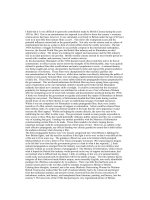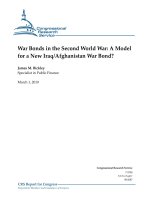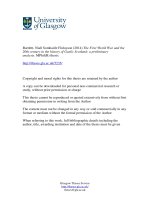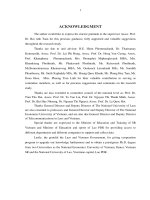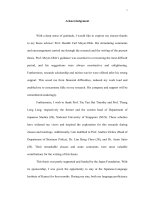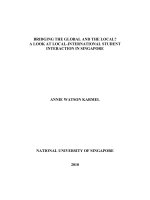Localizing memory scapes, building a nation commemorating the second world war in singapore
Bạn đang xem bản rút gọn của tài liệu. Xem và tải ngay bản đầy đủ của tài liệu tại đây (5.83 MB, 196 trang )
LOCALIZING MEMORYSCAPES,
BUILDING A NATION:
COMMEMORATING THE SECOND WORLD WAR
IN SINGAPORE
HAMZAH BIN MUZAINI
NATIONAL UNIVERSITY OF SINGAPORE
2004
LOCALIZING MEMORYSCAPES,
BUILDING A NATION:
COMMEMORATING THE SECOND WORLD WAR
IN SINGAPORE
HAMZAH BIN MUZAINI
B.A. (Hons), NUS
A THESIS SUBMITTED
FOR THE DEGREE OF MASTERS OF SOCIAL SCIENCES
DEPARTMENT OF GEOGRAPHY
NATIONAL UNIVERSITY OF SINGAPORE
2004
ACKNOWLEDGEMENT
‘Syukor Alhamdulillah!’ With the aid of the Almighty Allah, I have managed to
accomplish the writing of this thesis. Thank god for the strength that has been bestowed
upon me, without which this thesis might not have been possible indeed.
A depth of gratitude to A/P Brenda Yeoh and A/P Peggy Teo, without whose guidance
and supervision, I might not have been able to persevere with this endeavour. Thank you
for your limitless patience and constant support throughout the two years. To A/P Brenda
Yeoh especially: thanks for encouraging me to do this and also for going along with my
“conference-going” frenzy! It made doing my Masters all that more exciting.
A special shout-out to A. Jeyathurai, Simon Goh and all the others at the Singapore
History Consultants and Changi Museum who introduced me to the amazing, amazing
realm of Singapore’s history and the wonderful, wonderful world of historical research.
Your support and friendship through these years have made me realize just how critical
all of you have been in shaping my interests and moulding my desires in life. I have
learnt a lot which would definitely hold me in good stead all my life.
A very big thank you especially to Mrs. Lee, Sarin, Shu Yu, Pauline Phua, Juliana, Sok
Kia, Cheow Kheng, A/P Farrell, A/P Blackburn, officers of the NAS and many others
who put up with my constant harassment for interviews, information and all my other
unending requests. Without your input, this thesis would not have been written for sure.
Not forgetting also the lecturers and other individuals within the Department of
Geography who have helped me in some ways through the years, especially Pauline Lee
without whom the whole administrative “mambo-jambo” associated with my Masters’
would have really gone over my head.
There are, of course, the many Singaporean individuals and foreigners who took the time
to fill up the survey questionnaires, and those who spared even more time to be
interviewed further, without whom the thesis would not have been realized.
i
The thesis period would have been virtually impossible if not for the many guys and gals
of the Geography postgraduate community. A particular note of thanks to “FH” May M,
“babe” Serene, “big guy” Albert, “smooth-talking” OCE, “auntie” Theo, “LOTR” Karen
and “southpark” Winston for the perpetual bantering and for all the things you did to
make my time at NUS a bearable one. Also to those at ARI, credits to Wai Kit, Theresa,
Verene and Yati for putting up with my complaints and consistent pestering whenever I
needed to meet “the boss”. You all made me feel welcome (most of the time)!
And those of you from my own personal circle of friends: Yihui, Cheryl, Kelvin,
Jonathan, Ismail and many others. Thank you for your unconditional friendship, for
putting up with my constant mood-swings and for being there whenever I needed to vent
my frustrations. Simply put, I really feel truly blessed to have such great friends around
me. And Yamz, especially you, thank you for being the best friend anyone can have. I
might not have been sane or disciplined enough to complete this thesis if not for your
never-ending naggings, pep talks, and our illuminating “rums” sessions.
A very huge debt of gratitude to my family – my brothers and sisters especially – for all
the love you have showered me without seeking anything in return. Your constant
motivations and encouragement have really made me realize that I would not have been
able to do this without all of you behind my back. A person cannot ask for a more patient
and loving family as all of you. This thesis is as much a credit to all of you as it is to me.
I also salute all the men and women, who fought during the Second World War, without
whose courage, resolve, heroism and dedication, there would be no topic on war
commemoration to even speak of. Finally, thanks to all others who have rendered help to
me in some way during this period whom I might have missed out, and for that, sorry!
This thesis is dedicated to the loving memory of my Mother. May you rest in peace!
HAMZAH BIN MUZAINI
January 2004
ii
TABLE OF CONTENTS
ACKNOWLEDGEMENTS
i
TABLE OF CONTENTS
iii
LIST OF TABLES, FIGURES AND MAPS
viii
LIST OF PLATES
ix
SUMMARY
xi
CHAPTER ONE
NATION-BUILDING, MEMORYSCAPES AND SECOND WORLD WAR
COMMEMORATION IN SINGAPORE
1
1.1
The global-national-local nexus and the problematization of the “local”
1
1.2
The role of “collective memory” in nation-building
5
1.3
Contesting the past: conceptualizing the politics of landscape
9
1.4
Research objectives and thesis organization
11
CHAPTER TWO
LITERATURE REVIEW, CONCEPTUAL FRAMEWORK AND
METHODOLOGICAL ROUTES
2.1
15
Reviewing the literature: landscapes of memory and war commemoration 15
2.1.1 Memoryscapes as symbolic landscapes of nationhood
16
2.1.2
Memoryscapes as contested landscapes
18
2.1.3
Memoryscapes as sites of transnational commemorations
22
2.2
Memory-making strategies
25
2.3
Methodological routes
28
2.3.1
The production of war memoryscapes in Singapore
28
2.3.2
Popular perceptions of Singaporeans to war commemoration
30
iii
2.3.3
Transnational perceptions of foreign visitors
32
2.3.4
Research limitations
32
CHAPTER THREE
THE PRODUCTION AND “NATIONALIZATION” OF WAR
MEMORYSCAPES IN SINGAPORE
34
3.1
Introduction
34
3.2
Historical background to the Second World War
34
3.3
Commemorating the war in Singapore: the early years
37
3.3.1
The intermediate phase of war commemoration
39
3.3.2
The “nationalization” phase
42
3.4
3.5
3.3.3 Agencies of war commemoration
44
“Nationalizing” the war: adopted memory-making strategies
45
3.4.1
Narrating the war, representing the past
47
3.4.2
Locale and the role of “place memory”
51
3.4.3
Recreating war through physical and symbolic design
53
3.4.4
Performative memory and commemoration
56
Conclusion
59
CHAPTER FOUR
POPULAR ATTITUDES TO WAR COMMEMORATION – AND
MEMORYSCAPES – IN SINGAPORE
60
4.1
Popular attitudes of Singaporeans to war commemoration in Singapore
60
4.2
The importance of remembering the war in Singapore
60
4.2.1
62
Lack of “active” culture of war commemoration
4.2.2 Inappropriate behaviours and lack of respect given to war sites
66
iv
4.3
4.4
Reactions to state’s strategies of (war) memory-making
68
4.3.1
71
The salience of “locale” in war consumption
4.3.2 Questioning the “local” in “national” war commemoration
74
4.3.3
Agency in war commemoration
79
4.3.4
War sites as tourist attractions?
82
Conclusion
83
CHAPTER FIVE
THE CHANGI CHAPEL AND MUSEUM
85
5.1
Introduction
85
5.2
Memory-making at the Changi Chapel and Museum
85
5.2.1
“Localization” through “locale” and design
89
5.2.2
Shifting towards more “local” representations of war
90
5.2.3
The use of performative memory
92
5.3
5.4
5.5
Singaporeans’ “readings” of the site
94
5.3.1
Divergent viewpoints over “locale”
94
5.3.2
Working towards a more Singaporean memoryscape?
95
5.3.3
Lack of a culture of war commemoration
97
5.3.4
A landscape “too foreign/Christian” to be national?
98
The Museum as a transnational landscape
103
5.4.1 A more personal form of commemoration
104
5.4.2
105
A site of transnational collaborations and contentions
Conclusion
107
v
CHAPTER SIX
THE REFLECTIONS AT BUKIT CHANDU CENTRE
110
6.1
Official “reflections” in the making of a memoryscape
110
6.2
Nationalizing “reflections”, representing the “local”
113
6.2.1
Choice of “locale” and the politics of naming
114
6.2.2
Spatial design and the art of simulations
115
6.2.3
Narrating the history of the Malay Regiment
116
6.3
Transnational “reflections” over the “local” Malay Regiment
119
6.4
(Dis) Honouring memories of the Malay Regiment
124
6.5
Conclusion
130
CHAPTER SEVEN
PLACING THE “NATION”, THE POLITICS OF SPACE AND THE
PROBLEMATIZATION OF THE “LOCAL”
132
7.1
7.2
The three themes of war commemoration in Singapore
132
7.1.1
Placing the “national” between the “global” and the “local”
132
7.1.2
“Localizing” strategies of memory-making in Singapore
135
7.1.3
The problematization of the “local”
138
Future directions
142
APPENDICES
A
Profile of official interviewees
144
B
Profile of Singaporean interviewees
147
C
Profile of foreign interviewees
150
D
Sample of final questionnaire
153
E
List of war-related historical sites in Singapore marked by HSU
157
vi
F
Official brochure of Changi Chapel and Museum
158
G
Invitation card/ programme of a service held at the
Changi Chapel and Museum
161
H
Official brochure of Reflections at Bukit Chandu Centre
162
I
Promotional flyer for Bukit Chandu docu-drama produced by
SURIA channel
166
Official brochure of Fort Siloso, Sentosa
167
J
BIBLIOGRAPHY
170
vii
LIST OF TABLES, FIGURES AND MAPS
Tables
2.1
Demographic Profile of Singapore Respondents
31
4.1
Main reasons for the importance of remembering the war
60
4.2
Reasons for “inaction” in active commemorative activities
63
4.3
Main motivations for visiting war sites
66
4.4
Most appropriate strategies of commemorating the war
69
4.5
Agency responsible for producing war memoryscapes
79
4.6
Importance of tourism to war commemoration
82
Figures
2.1
Conceptual Framework
28
1.1
Map of Singapore showing war-related sites mentioned in the thesis
14
3.1
Malayan Campaign: Japanese landing and progress down the
Malaya Peninsula, 1941-2
36
Japanese landing on Singapore, 1942
36
Maps
3.2
viii
LIST OF PLATES
3.1
Changi Prison Chapel
42
3.2
A restored Changi Mural
42
3.3
A HSU plaque marking the historic Pasir Panjang pill-box
44
3.4
A HSU plaque marking the Punggol Beach site in four languages
50
3.5
Entrance to an original ammunition bunker at Labrador (War) Park
52
3.6
Simulated watch tower at Fort Siloso
54
3.7
Recreated gun displays at Fort Siloso
54
3.8
Civilian War Memorial located at the heart of the city
55
3.9
Chinese lighting joss sticks during a ceremony at the
Civilian War Memorial
57
3.10
Tertiary students on a tour of Kranji War Cemetery
59
3.11
Honouring the Malay Regiment at Kranji War Cemetery
59
4.1
Johore Battery during the opening
64
4.2
Johore Battery on a typical day
64
4.3
Students on a Learning Journeys tour
66
4.4
Students at the Changi Prison Chapel
66
4.5
ANZAC day dawn ceremony at Kranji
70
4.6
Remembrance DAY memorial at Kranji
70
4.7
Sarimbun Japanese landing site
72
4.8
HSU plaque marking the Sarimbun site
72
4.9
POW-built St Luke’s Chapel restored by STB
75
4.10
Dense foliage surrounding original gun emplacements at Labrador Park
80
ix
5.1
Night view of new Changi Chapel
87
5.2
A view inside the Museum
87
5.3
Heavy metal gates of the Museum
89
5.4
“Kampong” setting outside the Museum
89
5.5
One storyboard focused on the “local” war experiences
90
5.6
Memorial service at the Museum
93
5.7
In-house tour at the Museum
93
5.8
Notice of “local” church services held at the Changi Chapel
93
5.9
Foreign visitors to the Museum
97
5.10
Foreign attendees to memorial services
97
5.11
Memorial notes pasted on the chapel walls
103
5.12
Museum director showing foreign dignitaries around the Museum
107
5.13
Presentation of plaque to the Museum
107
6.1
External façade of the Centre
110
6.2
A bronze tribute to the courage of the Malay Regiment
111
6.3
Telephones to listen to war survivors’ testimonies
116
6.4
Recreation of Pasir Panjang battle scenes at the Centre
118
6.5
A prison cell (ala Changi Prison) mock-up
119
6.6
Bronze bust of Adnan Saidi
122
6.7
Roll of honour for the men of the Malay Regiment
122
6.8
Another marker dedicated to the battle at Pasir Panjang
127
x
SUMMARY
This thesis concerns itself with the way the Singapore state remembers its involvement in
the Second World War, and the politics of space associated with the production and
consumption of “local” memoryscapes to the war. While the thesis looks at war
commemoration within the nation in general, it also grounds the discussion by analyzing
two memorial sites – Changi Chapel and Museum and Reflections at Bukit Chandu
Centre. Data was gathered through archival, survey and interview techniques, using a
mix of qualitative and quantitative tools. The main findings are highlighted below.
First, in examining the way the Singapore state has attempted to spatially mobilize its war
memories as a tool of nation-building, the thesis shows how the endeavour is challenged
from within the nation as well as from outside, placing the configuration of the “national”
within the Singapore context as lying in a precarious intersection between “global” and
“local” forces. Upon investigating how the state has negotiated these challenges through
various strategies of memory-making, the state’s two-pronged aim in commemorating the
war becomes clear: to make its memoryscapes more resonant with Singaporeans while
still keeping it relevant for foreigners – particularly war pilgrims – who still visit them.
The thesis also looks at how successful the state has been in “localizing” – through its
memoryscapes – what was really a “global” war. While Singaporeans do see the war as a
pertinent aspect of the nation’s history, it has not translated into any real desire to support
the state’s remembrance of it more actively. Some Singaporeans have even (covertly)
resisted the way the state has commemorated the war, especially when they see it as a
xi
way in which the state has marginalized certain groups, as in the Reflections at Bukit
Chandu Centre, seen by the Malays as a site where their history is being sidelined. The
problem essentially lies in how the term “local” is defined. In Singapore, the state’s idea
of the “local” as representing all citizens has been deflected by how some Singaporeans
may define the term (e.g. as ethnically variegated). This shows how the views of the
people may not necessarily coincide with the state; where “localizing” the war in
Singapore becomes problematic in the light of the nation’s multiracial complexion. It also
exposes the over-simplicity of putting the “local” simply as a foil to “global” forces. As
the thesis shows, the term “local” itself is a fraught concept, even within the nation.
Apart from showing how such memoryscapes are contested from within the nation, the
thesis also shows how they can be contested from outside, as exemplified in the case of
the Changi Chapel and Museum, where, given the war as being “global” in character, and
its commemoration as transnational, other nations too may want to stake their own claims
over how the war is commemorated locally. More broadly, it shows how, when
considering “national” commemorations of such wars, it is critical to consider elements
that may emerge from beyond the nation as well. In that sense, the thesis shows that
memoryscapes of war in Singapore are indeed heavily contested as sites of nationhood.
KEY PHRASES
Memoryscapes; “global-local” nexus; politics of space; culture of commemoration;
Second World War; Singapore
xii
CHAPTER ONE
NATION-BUILDING, MEMORYSCAPES AND SECOND
WORLD WAR COMMEMORATION IN SINGAPORE
1.1
The global-national-local nexus and the problematization of the “local”
Recent theorizations on the concept of the “nation” within the domain of the social
sciences have generally accepted it as a “social-construct” and “the product of specific
historical and geographical forces” (Jackson and Penrose 1993: 1). Anderson (1983: 7)
refers to the “nation” as an “imagined community”, a group constituted by heterogeneous
individuals who may never know each other personally (hence “imagined”), yet feel a
sense of “community” or a “deep horizontal comradeship with one another” by virtue of
being in the same nation. This sense of the “community” extends even to members who
are dead, as “ghostly imaginings belonging to the same national community, thus
securing the nation’s imagined continuity and transcendence of time” (Ashplant et al.
2000: 8). The characteristics that members of a nation share with each other towards a
nation’s collective consciousness give rise to its “national identity” (Gillis 1994).
Given its socially-constructed nature, it has been postulated that this sense of collectivity
that the “nation” embodies is not stable and is constantly under threat (Kong and Yeoh
2003). Specifically, it is said to be in danger of being overcome by the onslaught of
globalization, facilitating the removal of national barriers to flows of information, capital,
people, ideas and commodities, hence collapsing time and space in the creation of a
“global village” (Radcliffe and Westwood 1996). One argument refers to the “nation” as
perpetually struggling to hold its own against the emergence of “global cultures”
(Lowenthal 1994), seeking to homogenize and erase the particularity of single nations.
1
The counter argument to this is that nations are not mere passive receivers of the
exogenous processes of globalization, and to say that nations would be rendered passé in
the light of these global forces does not necessarily hold true (Teo and Lim 2003). This is
because nations too may counter similarizing tendencies of global trends by exploiting
local particularity so as to keep intact its sense of “national identity”. Sack (1992) refers
to this process where nations react to globalization by “returning to local communities”
as “localization”; stressing the uniqueness of the “nation” so as to maintain its specificity
against foreign invasions prone to render it the same as other nations. As Robins (1991:
21) puts it, “the idea of nationality continues to have a powerful, if regressive, afterlife
and the sweeping [local] images which spring to life in times of [global] crisis testify to
its continuing force”. Hence, it is more instructive to conceive of the “nation” as an active
(rather than passive) actor in tension with (and reacting to) global forces that act upon it.
While the “global-local” dialectic has been discussed extensively elsewhere (see Bird et
al. 1993; Chang et al. 1996; Urry 1996), there has not been much interrogation of what it
actually means to promote the “local”. As Appadurai (1995: 207) puts it, “most studies
have taken locality as ground not figure, recognizing neither its fragility nor its ethos as a
property of social life”. Indeed, what is considered “local” is a fragile concept. First, for
the “nation” to be realized, there is the need to create a sense that all its inhabitants are
“the same” by virtue of belonging to one nation. The problem arises if one accepts that
members of most states today “include people who do not belong to its core culture or
feel themselves to be part of a nation so defined” (Hasting 1997: 3). Sub-national
affiliations may therefore fracture the collectivity that is the state’s desired formation, as
2
the state’s idea of “local” within the global arena may not be what the people in the
nation see as “local”. Hence, nation-building would require a process of uniting divergent
(sometimes dissonant) interests as a means of providing threads to bind its population.
Second, there is also a need to produce subjects who would be able to relate to the idea of
the “nation” – as the state envisions it – on a more personal level. Stressing “localization”
as a “structure of feeling”, Appadurai (1995: 206-7) avers that the idea of a “nation”
needs to be something not only produced by the state but also one that is continuously
reproduced by “local subjects possessed of the knowledge to reproduce [it]”. In that
sense, “localization” should allow for the “local” community to be directly in the act of
“living through the nation” or “the material and experiential procession of citizens
through the nation space” (Radcliffe and Westwood 1996: 118). As such, the notion of
“localization” transcends the mere presentation of the “local” to a global audience, but
one that reaches deep into the psyche of the people (within the nation); them embodying
and internalizing these “localization” processes, rather than just existing superficially for
the international community to reflect upon (Radcliffe and Westwood 1996).
To further problematize the “local”, it is also a product of the context in which the term is
defined. For one, the term “local” remains a “baffled” concept as any single “locality”
may be perceived differently by different groups of people living within the nation
(Appadurai 1995). In addition, the term “local” is also a historical concept in that it is a
product of “our” times (Rodman 1992) and therefore may change over time due to new
contexts. As Appadurai (1995: 210) puts it, as “local” subjects carry on the task of re-
3
producing the “local”, they are continuously faced with “the contingencies of history,
environment and imagination [which] contain potential for new contexts (material, social
and imaginative) to be produced” (Appadurai 1995: 210). Hence, “localization” needs to
be (re-) examined from both geographical and historical points of view.
There is therefore an apparent paradox in the process of “localization” as discussed here.
Hastings (1997: 34) summarizes this paradox: “nationalism is to be justified as an
appropriate protest against a universalizing uniformity … but its consequence is too often
precisely the imposition of uniformity, a deep intolerance of all particularities except [the
state’s] own”. While one purpose of nation-building is to preserve one’s “local” identity
amidst global forces, the other is to create a “national” culture that moulds diverse
realities within the nation. The problem, however, lies in that, given the multiculturalism
of most nations today, and problems with defining the “local”, forging a homogeneous
“national” culture may not be an easy feat to achieve. While, ideally, the “internalized
imaginings of the nation” (how the people of a “nation” define itself) should be the same
as the “externalized imaginings of the nation” (the idea of a “nation” the state projects
globally) (Radcliffe and Westwood 1996), this is rarely the case in reality.
The “national” is then placed at the muddy intersections of what is “global” and “local”,
given that the process of “localization” – and the shaping of the “national” – is a highly
embattled process involving the state, its people and global actors. As such, what can be
seen as “national” is neither merely the product of global forces, nor of specific
“localization” processes. In analyzing nation-building processes within states, it is more
4
useful perhaps to interrogate the complex interconnections of both global and local forces
and how they intersect with each other in how the “national” is configured (Urry 1996).
1.2
The role of “collective memory” in nation-building
Given external (global) or internal (local) threats to the “nation”, perceived or otherwise,
the ties that bind the “nation” together are therefore “fragile” and need to be continuously
“nurtured” (Kong and Yeoh 2003). “Nationalism” refers to the ideology behind this
“nurturing”, which calls for the invention of traditions to secure the “nation” and set it
apart from other nations, at the same time providing its inhabitants with the symbolic
capital to maintain its “imagined community” (Hobsbawm 1983). This capital which
provides “national” citizens with the sense of belonging to each other can be rooted in a
nation’s past, common culture or even sometimes fabricated ex nihilo as icons of a
nation’s identity. These invented traditions aim towards inculcating certain values and
norms of behaviour to foster group cohesion within the nation (Jackson and Penrose
1993). Central to this national “myth-making” is the notion of “collective memory”.
“Memory” is, to put it simply, an individual way of looking at the past (Davis and Starn
1989; O’Meally and Fabre 1994). While “memory” can be personal, it can also be shared
between people within the same group, producing what is known as “collective memory”.
In most cases, “collective memory” is forged through some common experience(s) shared
and sustained among members of that particular group (Halbwachs 1992). The
mobilization of “the force of history” (Kapferer 1988) in fulfilling certain objectives of
the present can be seen in the extensive efforts put by nations to reach into their reserves
5
of the past as a means of “rooting” its people, such as in preserving historic landscapes
(Datel and Dingemans 1988; King 1999), conserving archival records (Foote 1994),
drawing from past legends (Kapferer 1988) or in other acts of capitalizing upon history in
bringing the inhabitants within the “nation” together.
The salience of memory in the making of a “national” tradition lays in that it “holds the
fabric of belief together … underpins social cohesion [and] reminds us [of] who we are,
and what our place in that society actually is” (Kavanagh 2000: 43). For one, it serves to
justify ideologies that the state may want imposed on its people, as “our experience of the
present largely depends upon our knowledge and images of the past”, hence the value of
memory in the “legitimation of [national] authority and social cohesion” (Connerton
1989: 3). Collective memory also gives a nation a shared sense of its people and satisfy
their need for “roots” (Samuel 1994), distilling “the past into icons of identity, bonding us
with precursors and progenitors, with our own earlier selves and with our promised
successors” (Lowenthal 1994: 43), giving the nation a “distinctive historical
consciousness” (Cornwell and Stoddard 2001: 4).
The power of “collective memory” also lies in its ability to entice people to concede to
what the group, in this case the “nation”, believes even if it goes against what they
personally believed (Kavanagh 2000). According to Kapferer (1988: 2), “the meanings
[behind memories] carry implications for further action [and] can motivate action in
accordance with the direction of the nationalist argument”. In line with the transcendent
nature of the nation, memory also allows us to connect with the heroics of the dead as a
6
means of inspiring generations to emulate sacrifices made for the nation by other
“national” ancestors, hence securing “the willingness of current generations to die in [the
nation’s] defence” (Ashplant et al. 2002: 22). In creating a “national tradition”, therefore,
memory may “declare the nation to be whole and unified outside the mechanism of the
state” (Kapferer 1988: 23).
Bearing this in mind, Anderson (1983: 3) warns, however, that far from being definitive
truths, these inventions are merely “the cultural stuff out of which moral and material
systems are charged and transformed”. It is also important, therefore, to understand that
memory is contextualized and necessarily ideological (Yoneyama 1999). In forging a
“national” culture, collective memories that are fashioned by the state to become “official
history” may also seek to erase “traces of the past which seem to impede the work of a
new order” (Kwok et al. 1999: 6). At one extreme, it may even offer “a bogus history
which ignores complex historical processes and relationships, and sanitizes less savoury
dimensions of the past” (Johnson 1999: 190). Hence, official versions of the past are
defined as much by what they forget as by what they remember (Gillis 1994)
.
In that sense, “national memory” can be seen to involve the valorising of the past based
on present day evaluations, conditioned by present needs and contemporary problems
(Osborne 1998). However, the state’s version of a nation’s “collective memory” may not
necessarily be accepted by others (Nora 1994). Threats to “national” memory can emerge
from within the state, such as when the state’s version of a collective memory is
challenged by other versions of the same memory as held by members of that nation.
7
Threats may also emerge from external sources, especially when the past in question –
that is shaped by the state to add ballast to its task of nation-building – is one that
involved other nations as well. In the case of these “transnational” events, the way one
nation attempts to remember its history would also have to consider how other nations
would react to its interpretation of the event (Ashplant et al. 2000).
In this age of globalization, the salience of being sensitive to the reactions of other
nations cannot be ignored, since it is not possible for one nation to exist completely
divorced from the “interconnected world” (Teo et al. 2001) where nations are inevitably
dependent on global engagements if they are to succeed within it. As diplomatic courtesy,
or for fear of retaliation, nations do have to bear in mind how its actions affect other
nations. Further, in the case of “transnational” events involving death, such as a war that
takes place across national boundaries, the commemoration of the event may also be
transnational, such as when families embark on “pilgrimages” to overseas sites where
loved ones suffered or may be buried (Smith 1996). Hence, the way the event is recalled
within a nation would also have to consider how these “war pilgrims” would react.
Another facet of the global threat to national memory takes the form of what some
scholars have called “thanatourism” (Seaton 1999; Lennon and Foley 2000). This refers
to a type of alternative tourism defined as “travel to a location wholly or partially
motivated by the desire for actual or symbolic encounters with death” (Seaton 1999:
131). As such, there are some who travel to sites where wars have taken (or are taking)
place so as to get adrenaline rushes or simply for leisure. This is distinguished from “war
8
pilgrims” whose visits are motivated more by the desire for personal commemoration.
For nations with a legacy that may provide fodder for the rise of such tourism, no less as
they can contribute to tourism (Smith 1996), the demands of these tourists would also
need to be considered when representing the war, even within national boundaries.
According to Adams (2001: 266), besides the obvious commercial incentives that these
foreigners to a particular nation – “war pilgrims” or alternative tourists – bring in, they
also “contribute [towards] reconfiguring ethnic and national perceptions” of the events, as
they “become embroiled in and colour the politics of the places they [visit]”. Apart from
influencing these sites physically (or symbolically), these visitors may even be critical of
the way a state projects memories of the events (Blackburn 2000a). Hence, while
dissenting voices within a nation not aligned with the state’s version of a “national”
memory may be one form of resistance, there may also be forces emerging from
“outside”, giving rise to an “internationalization of heritage” where “[national] heritage is
no longer immune to outside judgement” as the global community becomes an active
player in the decision on what merits safeguarding (Lowenthal 1994: 48).
1.3
Contesting the past: conceptualizing the politics of landscape
In illuminating some of the above nuances, geographers have centred upon the analysis of
“landscapes” and “landscape representations” (Jackson and Penrose 1993; Mitchell
2002). In line with developments within the field of cultural geography, landscapes are
understood to reflect and reproduce social relations and the politics inherent in them
(Price and Lewis 1993). According to Cosgrove and Jackson (1987: 96), “landscape” is
9
“a particular way of composing, structuring and giving meaning to an external world
whose history has to be understood in relation to the material appropriation of land”. It
can be physical – material changes over space – or symbolic in the shape of meanings
invested on and over space which are not directly verifiable by the senses. Hence, apart
from the directly visual, there is also a need to highlight the symbolism inscribed in
landscapes which produce and sustain social meanings.
Landscapes are often seen as convenient canvases on which the state writes its national
memory, as a means of naturalizing it, such that “they are read and experienced as
‘common-sense’, creating what is experienced as an adequate and unalienated
representation of subjects’ lives” (Radcliffe and Westwood 1996: 11). This is what is
referred to as “hegemony” which “does not involve controls which are clearly
recognizable as constraints in the traditional coercive sense” but “a set of ideas and
values which the majority are persuaded to adopt as their own” (Kong and Yeoh 2003:
11-2). When memory is set onto space, they become lieux de memoire, or mnemonic
devices and anchors where “memory crystallizes and secretes itself” (Nora 1994: 284).
Hence, through landscapes, “national” memory may be transformed from something that
is shifting to one fixed: “from an external phenomenon to be engaged visually, to a
psychic terrain of internalized symbolic meaning” (Osborne 1998: 433).
However, while such mediation over space holds out the potential hegemony of official
national identities, what has been “written” onto landscapes may not necessarily be
“read” the same way from below (Kong and Yeoh 2003). In that sense, landscapes can be
10
“denaturalized ... [or] changed physically or reinterpreted to reflect challenges to the
dominant value system” (Duncan and Duncan 1988: 125). Resistance to the state’s
forwarded history may be achieved through overt confrontations or via more latent means
“assembled out of the materials and practices of everybody life (Pile cited in Yeoh 2003:
42). While the former may seek to attain more immediate results, the latter may take
place over time as they “invent new trajectories, and forms of existence, articulate
alternative futures and possibilities [and] create autonomous zones as a strategy against
particular dominating power relations” (Routledge cited in Yeoh 2003: 42).
In that sense, the interpretation of landscapes is very much “locked within relations of
power” giving it its dual character: “as a repository of elite or state power and as a site of
individual and collective struggle and resistance” (Yeoh and Kong 1996: 53). While this
may take place within the nation, they can also unveil complex contestations between
nations if the event (or its commemoration) was a transnational one. Memoryscapes
therefore provide a good medium to examine how national memory is mediated between
forces from within as well as those that lie beyond the nation, making them effective
“lens” through which geographers can examine political processes that go into how
memories are appropriated today. The issues discussed thus far would empirically draw
upon and fold into the case of the Second World War and its remembrance in Singapore.
1.4
Research objectives and thesis organization
This thesis concerns itself primarily with the processes that have gone (and are still
going) into how the Second World War has been – and is still presently being –
11

